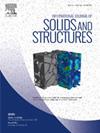Extension of von-Mises failure criterion for comprehensive mixed-mode I/II fracture assessment of orthotropic materials
IF 3.4
3区 工程技术
Q1 MECHANICS
International Journal of Solids and Structures
Pub Date : 2025-03-27
DOI:10.1016/j.ijsolstr.2025.113363
引用次数: 0
Abstract
This study aims to propose a general fracture criterion for cracked orthotropic materials that incorporates normal and shear modes of fracture. For this purpose, an extension of the von-Mises failure criterion, commonly applied to isotropic materials, is utilized to analyze the fracture behavior of orthotropic materials within the linear elastic fracture mechanics (LEFM) framework. The new failure criterion presented in this research is called the extended von-Mises criterion (EVM). The presented criterion is promoted in conjunction with reinforced isotropic solid (RIS) concept which is an efficient material model suitable for orthotropic materials. Thus, the role of the fibers in strengthening the matrix is considered as coefficients in the isotropic stress field of the matrix. This combination is able to properly account for the reinforcing effects of the fibers and the anisotropic mechanical properties of the materials and improve the accuracy of failure predictions. EVM criterion is presented for two different crack propagation scenarios: along and perpendicular to the fibers. In the latter case, kinked crack phenomenon is considered involving crack rotation along the fiber direction, upon encountering the fibers. To investigate EVM accuracy and applicability, this criterion is examined for some wooden species. The fracture limit curves of EVM show promising results when compared to experimental data, indicating that the proposed criterion can accurately predict the failure behavior of materials. It demonstrates performance comparable to the energy-based criterion. The application of RIS theory to enhance this criterion led to a notable increase in its predictive accuracy, suggesting a deeper understanding of the material’s behavior. This enhancement improved performance by 17–20%, and the analysis of the results was conducted with greater precision.
正交各向异性材料综合混合模式I/II断裂评价中von-Mises破坏准则的推广
本研究的目的是提出一个通用的断裂准则的开裂正交各向异性材料,包括正常模式和剪切模式的断裂。为此,将通常应用于各向同性材料的von-Mises破坏准则进行扩展,在线弹性断裂力学(LEFM)框架内分析正交各向异性材料的断裂行为。本文提出的新的破坏准则被称为扩展的von-Mises准则(EVM)。该准则与增强各向同性固体(RIS)概念相结合,是一种适用于正交异性材料的有效材料模型。因此,纤维对基体的强化作用可以看作是基体各向同性应力场的系数。这种组合能够合理地考虑纤维的增强作用和材料的各向异性力学性能,提高失效预测的准确性。给出了沿纤维和垂直于纤维两种不同裂纹扩展情况下的EVM准则。在后一种情况下,考虑扭结裂纹现象,即裂纹在遇到纤维时沿纤维方向旋转。为了考察EVM的准确性和适用性,对一些木材品种进行了检验。将EVM断裂极限曲线与实验数据进行对比,结果表明该准则能够准确预测材料的破坏行为。它展示了与基于能量的标准相当的性能。RIS理论的应用提高了这一标准,导致其预测精度显著提高,这表明对材料行为有了更深入的了解。这种增强将性能提高了17-20%,并且对结果进行了更精确的分析。
本文章由计算机程序翻译,如有差异,请以英文原文为准。
求助全文
约1分钟内获得全文
求助全文
来源期刊
CiteScore
6.70
自引率
8.30%
发文量
405
审稿时长
70 days
期刊介绍:
The International Journal of Solids and Structures has as its objective the publication and dissemination of original research in Mechanics of Solids and Structures as a field of Applied Science and Engineering. It fosters thus the exchange of ideas among workers in different parts of the world and also among workers who emphasize different aspects of the foundations and applications of the field.
Standing as it does at the cross-roads of Materials Science, Life Sciences, Mathematics, Physics and Engineering Design, the Mechanics of Solids and Structures is experiencing considerable growth as a result of recent technological advances. The Journal, by providing an international medium of communication, is encouraging this growth and is encompassing all aspects of the field from the more classical problems of structural analysis to mechanics of solids continually interacting with other media and including fracture, flow, wave propagation, heat transfer, thermal effects in solids, optimum design methods, model analysis, structural topology and numerical techniques. Interest extends to both inorganic and organic solids and structures.

 求助内容:
求助内容: 应助结果提醒方式:
应助结果提醒方式:


